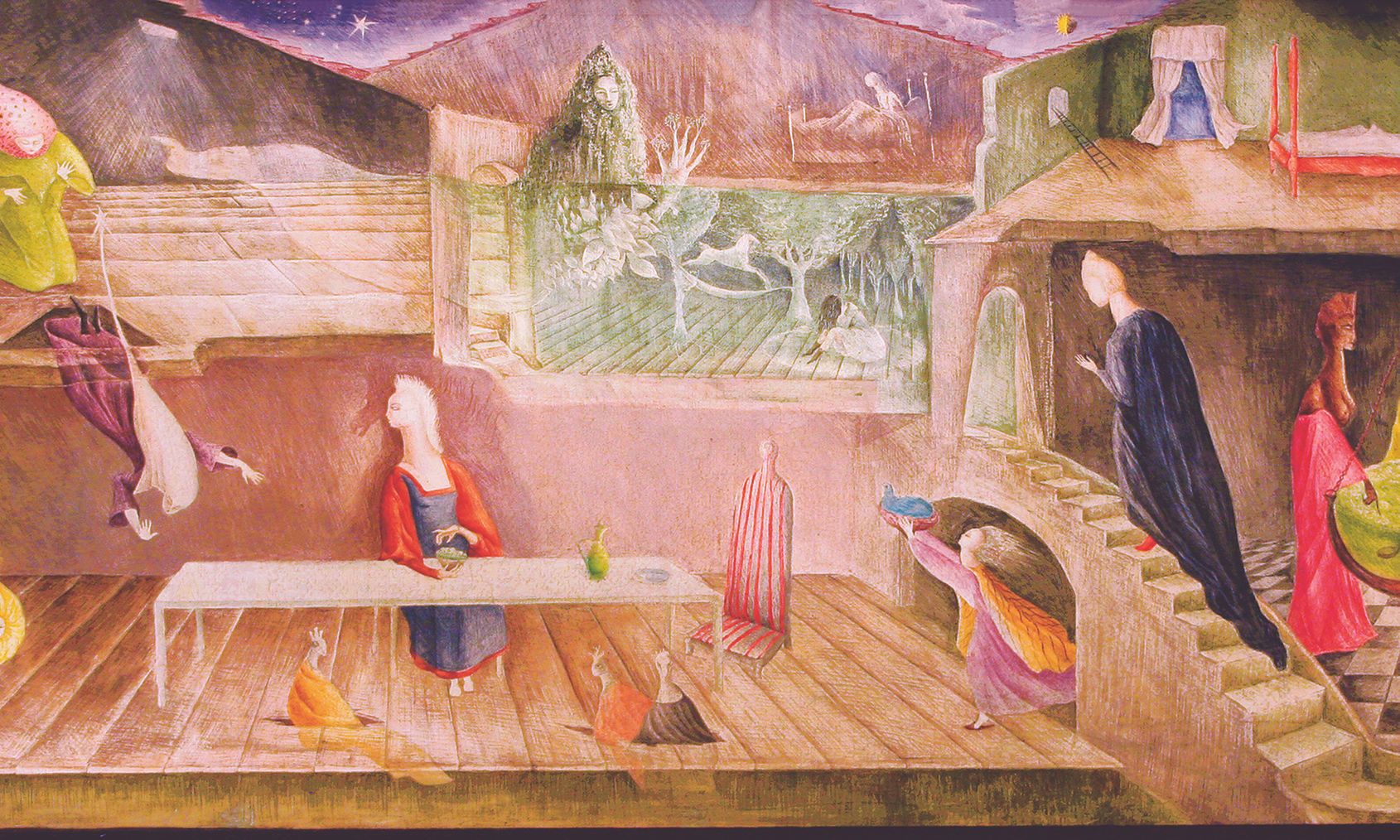Courtesy West Dean College of Arts and Conservation © Estate of Leonora Carrington
Hyenas, horses and bats team through the paintings and stories of Leonora Carrington (1917-2011), associated with revolt, freedom and fear. The precision of her detail—in a painting style initially developed out of the Florentine Quattrocento—could place the macabre in the service of subversion. As she found her creative loadstone, so her growing commitment to feminism coincided with her exploration of esoteric and unconventional belief systems.
As an illustrated biography, Surreal Spaces is underscored by the author’s family connection with her subject: Carrington was the daughter of Joanna Moorhead’s great aunt. The codes of Edwardian England, anachronistically blending fox hunting and the aspirational marriage market, were unable to contain Carrington’s demand to make her own world. At the age of 20 the call of painting and Surrealism combined in an idyllic moment of connection with Max Ernst—with whom she scandalously formed a relationship, although he was married—before the Second World War crashed in and Carrington descended into a tortured incarceration in a Spanish asylum, eventually escaping through Lisbon to New York and Mexico.
Moorhead retells this, by now familiar, story with energy. She vividly recounts the improbable survival of Les Alliberts, the house that Carrington bought and shared with Ernst in Saint-Martin d’Ardèche, which remains virtually unchanged since she had to abandon it in 1940—even to the point of retaining the artist’s wall paintings, her books on the bookcase and her letters in the desk.
Moorhead has already mined this material for her earlier book, The Surreal Life of Leonora Carrington (Virago 2017), and while the story certainly bears retelling, this revisiting is rather passed over in Surreal Spaces. Those who have read the previous book will be familiar with the narrative voice and will find echoes of specific phrasing. While hardly surprising, this doubling begs questions about the relationship between the publications. As this is only addressed directly once (when the identification of the house that Carrington occupied in Lisbon is changed), it is left to the reader to decide whether the new research acts as a corrective or as an augmentation. As Surreal Spaces offers a wealth of new information but does not purport to be a scholarly art historical account, this is simply tantalising, and—as any account of Carrington’s life is worthwhile—should perhaps encourage enthusiasts to read both.
What the new book brings, as suggested in the title, is a closer account of the places of Carrington’s life and production, from the Inn of the Dawn Horse (the title of her self-portrait of 1937-38) to 194 Calle Chihuahua, her long-term home in Mexico City (recently opened as a house-museum). Moorhead has retraced each stage of her cousin’s multiple migrations. In the early chapters the family background is explored, and familiar paintings are linked to Carrington’s childhood homes, especially the Alfred Waterhouse-designed Crookhey Hall (near Lancaster) of her earliest years.
Clearly it is in the moments of rebellion that Moorhead finds greatest riches: the chapter on the summer of 1937 with Ernst and other Surrealists hiding in Cornwall from Carrington’s vengeful father amounts to nearly half the length of that covering 26 years in Mexico. This seems to reflect the plunge into distant memory that Carrington shared with Moorhead during their twice-yearly encounters in the final five years of the artist’s long life.
Carrington resisted theorising around her works, so that, although several art historians and scholars of literature are cited (Susan Aberth, Whitney Chadwick, Gloria Orenstein, Penelope Rosemont), there is a preference for responses rather than analysis. This is slightly paradoxical, as it is just those scholars (and many others) who have, over 40 years or so, helped to re-establish the position for Carrington’s work that it has long deserved. Substantial publications include Leonora Carrington and the International Avant-Garde (Manchester University Press 2017)—with contributions from the artist’s son, Gabriel Weisz Carrington—and the catalogue accompanying the exhibition Leonora Carrington: Revelation, curated by Tere Arcq and Carlos Martin and currently on show at the Fundación MAPFE in Madrid (until 7 May).
There is a welcome profusion of illustrations in Surreal Spaces that alone justifies revisiting the material. Several paintings, however, are illustrated but not mentioned, and, more frustratingly, some are discussed but not illustrated. Given the need to guard against Carrington being pigeonholed as muse to Ernst, it seems unfortunate to reproduce two of his illustrations for her book The House of Fear rather than her painting The Meal of Lord Candlestick (1938). The Mexican chapter would have benefited from examples of the work of Remedios Varo and Kati Horna (which Moorhead included in the 2010 exhibition she organised with Tere Arcq and Stefan van Raay, Surreal Friends at Pallant House Gallery, Chichester).But these are minor quibbles over a spirited account of Carrington’s work and life, with whom the author openly identifies and whose footsteps she has followed with care and imagination.
• Matthew Gale is an independent art historian and curator
• Joanna Moorhead, Surreal Spaces: The Life and Art of Leonora Carrington, Thames & Hudson, 256pp, 80 illustrations, £30 (hb), published 1 June

